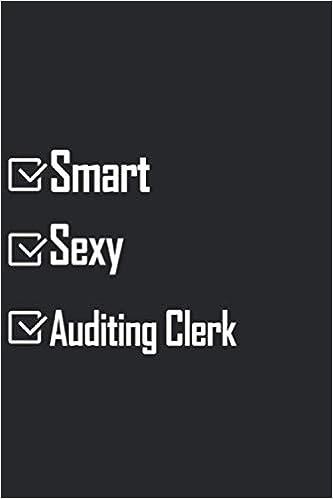Question
Arthur Edward Andersen built his firm, Arthur Andersen & Company, into one of the largest and most respected accounting firms in the world through his
Arthur Edward Andersen built his firm, Arthur Andersen & Company, into one of the largest and most respected accounting firms in the world through his reputation for honesty and integrity. Think straight, talk straight was his motto and he insisted that his clients adopt that same attitude when preparing and issuing their periodic financial statements. Arthur Andersens auditing philosophy was not rule-based, that is, he did not stress the importance of clients complying with specific accounting rules because in the early days of the U.S. accounting profession there were few formal rules and guidelines for accountants and auditors to follow. Instead, Andersen invoked a substance-over-form approach to auditing and accounting issues. He passionately believed that the primary role of the auditor was to ensure that clients reported fully and honestly to the public, regardless of the consequences for those clients.
Ironically, Arthur Andersen & Co.s dramatic fall from greatness resulted from its association with a client known for aggressive and innovative uses of accounting gimmicks to window dress its financial statements. Enron Corporation, Andersens second largest client, was involved in large, complex transactions with hundreds of special purpose entities (SPEs) that it used to obscure its true financial condition and operating results. Among other uses, these SPEs allowed Enron to download underperforming assets from its balance sheet and to conceal large operating losses. During 2001, a series of circumstances, including a sharp decline in the price of Enrons stock, forced the company to assume control and ownership of many of its troubled SPEs. As a result, Enron was forced to report a large loss in October 2001, restate its earnings for the previous five years, and, ultimately, file for bankruptcy in December 2001.
During the early months of 2002, Andersen became the focal point of attention among law enforcement authorities searching for the parties responsible for Enrons sudden collapse. The accusations directed at Andersen centered on three key issues. The first issue had to do with the scope of professional services that Andersen provided to Enron. Critics charged that the enormous consulting fees Enron paid Andersen impaired the audit firms independence. The second issue stemmed from Andersens alleged role in Enrons aggressive accounting and financial reporting treatments for its SPE-related transactions. Finally, the most embarrassing issue was the massive effort of Andersens Houston office to shred Enron audit documents, which eventually led to the demise of the firm.
Enron/Anderson Scandal Key Facts
1. Throughout Arthur E. Andersens life, Think Straight, talk straight served as a guiding principle for himself and Arthur Andersen & Co., the accounting firm that he founded. Arthur Andersens reputation for honesty and integrity resulted in Arthur Andersen & Co. gaining status in the business community and growing into one of the leading accounting firms by the time of his death in 1947.
2. Leonard Spacek succeeded Arthur Andersen as managing partner of Arthur Andersen & Co. in 1947 and continued Andersens legacy of lobbying for more rigorous accounting, auditing, and ethical standards for the public accounting profession.
3. When Spacek retired in 1973, Arthur Andersen & Co. was one of the largest and, arguably, the most prominent accounting firm worldwide
4. The predecessor of Enron Corporation was a natural gas company created in 1930; steady growth in profits and sales and numerous acquisitions allowed Enron to become the largest natural gas company in the United States by the mid-1980s.
5. During the 1990s, Kenneth Lay, Enrons CEO, and his top subordinate, Jeffrey Skilling, transformed the company from a conventional natural gas supplier into an energy trading company.
6. Lay and Skilling placed a heavy emphasis on strong earnings performance and on increasing Enrons status in the business world.
7. Enron executives used hundreds of SPEs (special purpose entities) to arrange large and complex related party transactions that served to strengthen Enrons reported financial condition and operating results.
8. Enron entered the year 2001 as the seventh largest public company in the U.S., only to exit the year as the largest company to ever declare bankruptcy in U.S. history (until WorldComs bankruptcy in 2002 later claimed the record).
9. Financial accounting standards played a role in that some of Enrons questionable accounting strategies were in technical compliance with generally accepted accounting principles (GAAP), despite clearly violating the intent of those standards.
10. Following Enrons collapse, the business press and other critics began searching for parties to hold responsible. Criticism of Andersens role in the Enron disaster focused on three key issues: the large amount of consulting revenue the firm earned from Enron, the firms role in many of Enrons SPE transactions, and the efforts of Andersen personnel to destroy Enron audit documents.
11. Andersens fall from grace was a result of the firms loss of reputation as a result of a long string of audit failures (including Waste Management, Global Crossing, Sunbeam, Qwest Communications, Enron, and eventually WorldCom). The firms conviction on federal charges of obstruction of justice in June 2002 effectively ended the firms long and proud history in the public accounting profession.
12. Audit fee revenues from such companies as Enron are very lucrativeAndersens audit fee at Enron was about $48 million per year. It is interesting to note that in 2000, Andersen earned more from Enron in consulting fees than in auditing fees, with consulting fees of over $52 million.
Question:Explain how rules-based accounting standards differ from principles-based standards. Could principle-based standards help prevent another Enron-like disaster in the USA in the future? Why or why not?
Step by Step Solution
There are 3 Steps involved in it
Step: 1

Get Instant Access to Expert-Tailored Solutions
See step-by-step solutions with expert insights and AI powered tools for academic success
Step: 2

Step: 3

Ace Your Homework with AI
Get the answers you need in no time with our AI-driven, step-by-step assistance
Get Started


